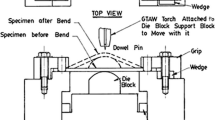Abstract
Liquation cracking may occur in the heat-affected zone during welding. Two factors influence this phenomenon: the tensile stresses generated during welding and the potential loss of ductility due to the presence of a liquid film at grain boundaries depending on their chemical composition. Gleeble hot ductility tests have been used to study the combined effect of boron content and holding time on ductility drop in the liquation temperature range of a 316L type austenitic stainless steel. It is shown that high boron contents and short holding times promote the loss of ductility in this temperature range. Secondary ion mass spectrometry has been used to correlate mechanical results to boron distribution either at grain boundaries or in the bulk. Other welding tests have been performed to confirm the influence of boron content on hot cracking sensitivity of AISI 316L stainless steels. Results indicate that cracks appear on all specimens but at different strain levels. The higher the boron content is, the more the specimen exhibits tendency to hot cracking.















Similar content being viewed by others
References
E. Folkhard, Welding Metallurgy of Stainless Steels, Springer, New York, 1988
J.C. Lippold, Welding Metallurgy and Weldability, Wiley, New York, 2014
R.D. Thomas, Jr., HAZ Cracking in Thick Sections of Austenitic Stainless Steels—Part II, Weld. J., 1984, 63(9), p 355s–368s
X. Huang, M.C. Chaturvedi, N.L. Richards, and J. Jackman, The Effect of Grain Boundary Segregation of Boron in Cast Alloy 718 on HAZ Microfissuring—A SIMS Analysis, Acta Mater., 1997, 45(8), p 3095–3107
R.K. Sidhu, O.A. Ojo, and M.C. Chaturvedi, Microstructural Response of Directionally Solidified René 80 Superalloy To Gas-Tungsten ARC Welding, Metall. Mater. Trans., 2009, 40A, p 150–162
H. Guo, M.C. Chaturvedi, and N.L. Richards, Effect of Boron Concentration and Grain Size on Weld Heat Affected Zone Microfissuring in Inconel 718 Base Superalloys, Sci. Technol. Weld. Join., 2013, 4(4), p 257–264
W. Chen, M.C. Chatuverdi, and N.L. Richards, Effect of Boron Segregation at Grain Boundaries on Heat-Affected Zone Cracking in Wrought Inconel 718, Metall. Mater. Trans. A, 2001, 32A, p 931–939
O.A. Ojo and M.C. Chatuverdi, Liquation Microfissuring in the Weld Heat-Affected Zone of an Overaged Precipitation-Hardened Nickel-Base Superalloy, Metall. Mater. Trans., 2007, 38A, p 356–369
G. Li, X. Lu, X. Zhu, J. Huang, L. Liu, and Y. Wu, The Segregation and Liquation Crackings in the HAZ of Multipass Laser-Welded Joints for Nuclear Power Plants, J. Mater. Eng. Perform., 2017, 26(8), p 4083–4091
G. Zacharie, Influence du bore sur la résistance à la fissuration à chaud dans les zones affectées par le soudage et sur la tenue au fluage des aciers 18–10Ti. Ph.D. dissertation. Université de Paris-Sud, 1978.
J.R. Donati, D. Guttmann, and G. Zacharie, Influence de la teneur en bore sur la fissuration à chaud d’aciers 18–10, Revue de Metallurgie (Paris), 1974, 71(12), p 917–930
G. Srinivasan, M. Divya, C.R. Das, S.K. Albert, A.K. Bhadurri, S. Lauf, S. Tubenrauch, and A. Klenk, Weldability Studies on Borated Stainless Steel Using Varestraint and Gleeble Tests, Weld. World, 2015, 59, p 119–126
W. Lin, J.C. Lippold, and W.A. Baeslack, An Evaluation of Heat Affected Zone Liquation Cracking Susceptibility Part I, Weld. J., 1993, 71(4), p 135s–153s
R. Boudot, and G. Zacharie, Influence de la teneur en bore sur la résistance à la fissuration à chaud dans les zones affectées par le soudage d’acier 18%Cr-12%Ni au molybdène en relation avec le mode d’élaboration. 25eme. Colloque de Métallurgie-Progrès Récents dans l‘Elaboration des Métaux et Alliage, Conséquences sur leur Propriétés d’Emploi, Saclay, 23–25 Juin, 1982
L. Karlsson, H. Nordén, and H. Odelius, Non-equilibrium Grain Boundary Segregation of Boron in Austenitic Stainless Steel - I. Large Scale Segregation Behavior, Acta Metall., 1988, 36(1), p 1–12
L.O. Osoba, Z. Gao, and O.A. Ojo, Physical and Numerical Simulations Study of Heat Input Dependence of HAZ Cracking in Nickel Base Superalloy IN 718, J. Metall. Eng., 2013, 2(3), p 88–93
C.D. Lundin et al., Hot Ductility and Hot Cracking Behaviour of Modified 316 Stainless Steels Designed for High Temperature Service, Weld. J., 1993, 72(5), p 189s–200s
T. Kannengiesser and K. Boellinghaus, Hot Cracking Test. An Overview of Present Technologies and Applications, Weld. World, 2014, 58(3), p 397–421
G. Tirand, C. Primault, and V. Robin, Sensibilité à la fissuration à chaud des alliages base nickel à haute teneur en chrome, High chromium nickel base alloys hot cracking susceptibility, Matér. Tech., 2014. https://doi.org/10.1051/mattech/2014035
Acknowledgment
The Gleeble 3500 machine of Université Bretagne Sud was co-financed by European Regional Development Fund (ERDF). The authors are grateful to A. Magueresse (Université Bretagne Sud) for the SEM images and to G. Tirand (Areva NP) for the realization of the PVR tests.
Author information
Authors and Affiliations
Corresponding author
Rights and permissions
About this article
Cite this article
Tran Van, G., Carron, D., Le Masson, P. et al. Effect of Boron Content on Hot Ductility and Hot Cracking Susceptibility in 316L Austenitic Stainless Steel for Welding Components. J. of Materi Eng and Perform 27, 5114–5123 (2018). https://doi.org/10.1007/s11665-018-3640-z
Received:
Revised:
Published:
Issue Date:
DOI: https://doi.org/10.1007/s11665-018-3640-z




